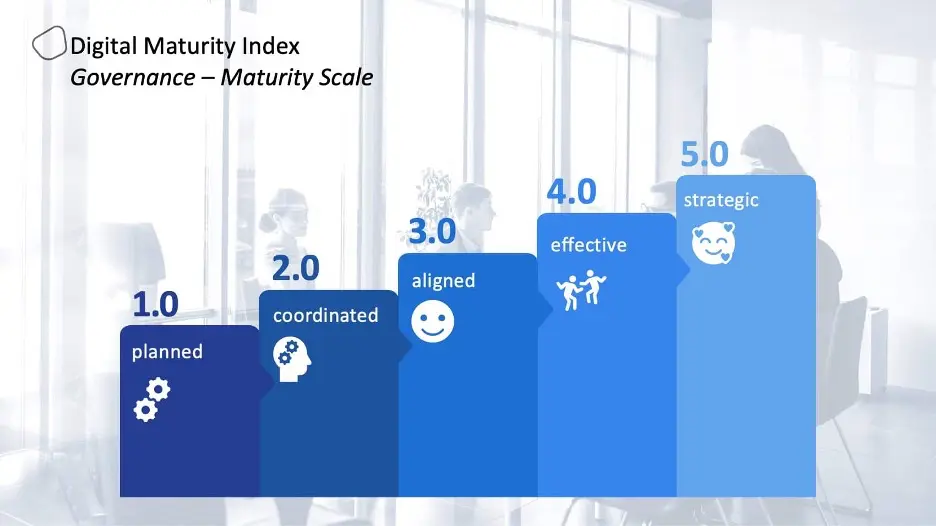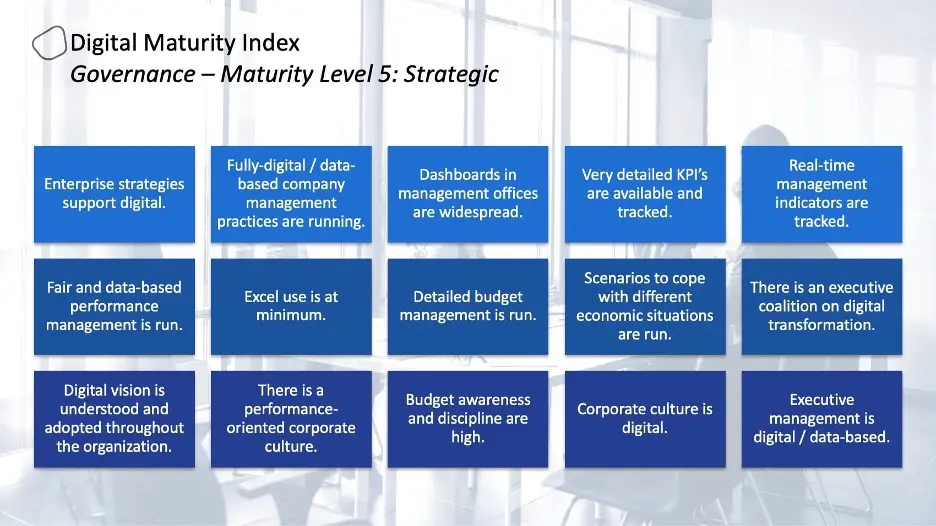
“Governance”, by definition, holds a lot of power. An even stronger concept within an organisation, governance is all about decision making. Organisations must frequently make decisions that affect the future of the company. These decisions range from spending and investments to strategy and customers; products, employees, and the digital agenda are all under the umbrella of this power.
The strategy of any organisation is the brainchild of senior executives and their closest allies. A C-suite level strategy involves goals achieved through associated initiatives, funded by a determined budget, scheduled and executed though the planning roadmap, and then reviewed by the executive committee. Digital transformation works in a similar way and must be embedded into the overall corporate governance.
We believe digital transformation is a team sport and requires executive leadership. In the “governance” dimension of the Digital Maturity Index, we examine how much digital has become part of the overall corporate structure.

To achieve excellence in governance, an organisation must succeed in many components. We have structured them into four main groups: the Foundation, the Administration, the Performance, and the Analytics. All of them are equally important, tightly integrated, and must improve simultaneously to mature and achieve success.
The Foundation group includes the corporate strategy, the direction of appropriate leadership and defined governance structures, working together effectively and efficiently.
The Administration group includes all processes in finance, legalities, risk control, compliance, and the sustainability agenda. The administration can become completely digital within a few decades, but duties such as creative questioning, reasoning, and envisioning will remain human.
The Performance group becomes increasingly important and is therefore measured precisely and monitored in real-time. Having defined metrics and KPI’s, being able to connect all relevant systems and collect all relevant data into dashboards to analyse and understand performance indicates true digital capability.
Last, but definitely not least, the Analytics group is about analysing all financial and performance related data, establishing dashboards, managing risk, discovering fraud or any other forgery within the organisation, and providing leading insight into the executive suite of the organisation for better decision making.
The accumulation of all the above show the digital maturity of the governance dimension, which is an integeral part of the digital capabilities an organisation must have to steer the digital journey in the right direction.

Our digital maturity index measures on a scale from 1.0 to 5.0. The first maturity level indicates very basic governance, so we have labelled it “planned”. Going up to the highest level, which we have called “strategic”, describes state-of-the-art governance capability, including strong decision making, sound financial management, and precise performance management.
Our studies from the recent past have shown that the “governance” dimension truly makes a difference. In this area, companies tend to be stronger and more digital than in other dimensions. Digitalisation has begun within the financial systems in the company, and upper management prioritises a strong hand on finance and risk.
The difference between champions and laggards in this dimension is more about analytics, precision and the speed of data. Champions have automated, integrated and digitalised their reporting, their analytics, their performance monitoring and even their decision making.
Governance should not turn into an ivory tower. It should be woven into the leadership fabric of the organisation. Decision making should become better informed, faster in response, and over time mostly automated. Performance management should transform from monthly reports into online dashboards with automatic alerts, recommended actions, and simulation capabilities. This would be true digital transformation in governance and leadership.
Brief descriptions of each level can be found in the graphic below:

During our work with companies, we have discovered that CFO’s play a central role in the governance of their organisations. After all, everything is connected to the budget. Better businesses do it politely and in a constructivly. The stricter ones affect people, projects, and progress, which results in lower digital maturity and slows down the digital transformation journey.
We also discovered that financial sector players have developed a protective mechanism due to the inflation of audit, risk assessment, due diligence study, and the like. Since some of them are judged by the number of findings or inconsistencies, let alone fraud or forgery or even worse, they tend to protect their accounts, systems, and information like a fortress. This can be both good, and bad. Good, because information security and privacy are crucial and is becoming a bigger concern as the number and complexity of digital assets increase. Bad, because it becomes more rigid and may inhibit agile decisions, new business models, off-budget spending and the realisation of short-notice opportunities.
Governance must be strong and stiff. But on the other hand, it must also be sufficiently flexible to support growth, change, and the digital transformation journey as a whole. It takes mastery in executive leadership to balance and enable “invisible” governance, just like magic.

Based on all our experiences and the best practices we have examined, we have described the most advanced level, the most strategic digital maturity in the governance dimension one can imagine, as of today.
Imagine a company with an executive leadership team that is fully aligned, truly convinced of the importance of digital transformation, and aware of its urgency.
Imagine a company with an executive leadership that is defined and fully committed to a shared vision, and that vision is understood and internalised by every single employee in the organisation.
Imagine a company, which has a balanced scorecard that encompasses digital KPI’s equally as financial, customer, operational and learning. Digital strategies and roadmaps are defined, tactics, initiatives and responsibilities are clearly assigned and closely monitored.
Imagine a company where all KPI’s are digitally monitored, dashboards are everywhere and accessible to everyone, performance is monitored online in real-time; alerts, most decisions, simulations are executed automatically.
Imagine a company where basic spreadsheets have disappeared, budgeting is a fluid process, operations are mostly automated, governed openly and evenly in a distributed manner; spending, forecasts, approvals or reviews are carried out by automated systems, leadership is alerted on anomalies and exceptions.
Imagine a company which has turned the above into a corporate culture, has automated all routine and recurring work, all humans focus on value added, reasoning, and improving, based on all the analytics and wisdom from the underlying systems.
Sounds great? Impossible? Definitely not. But it may take some time. To be able to achieve it, you must start the journey. Let’s work together. Start with measuring where you are and set the direction where you need to go.
Check out the rest of the articles in our Digital Maturity Explained series and learn more about all the dimensions of Digitopia’s Digital Maturity Index.
Digital Maturity Explained: All About Business Performance
Digital Maturity Explained: Governance, Reimagined
Digital Maturity Explained: Operations, Rebooted
Digital Maturity Explained: Technology, Reset
Digital Maturity Explained: Innovation, Reignited

